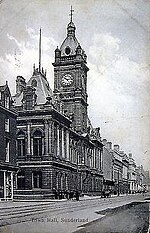City of Sunderland

The City of Sunderland () is a metropolitan borough with city status in the metropolitan county of Tyne and Wear, North East England. It is named after its largest settlement, Sunderland, spanning a far larger area, including nearby towns including Washington, Hetton-le-Hole and Houghton-le-Spring, as well as the surrounding suburban villages. The district also forms a large majority of Wearside which includes Chester-le-Street in County Durham. The district was formed in 1974 as part of the provisions of the Local Government Act 1972 and is an amalgamation of four former local government districts of County Durham. It was granted city status in 1992, the Ruby Jubilee of Queen Elizabeth II's accession to the throne. The borough had a population of 275,400 at the time of the 2011 census, with the majority of the population (174,286) residing in Sunderland.
Excerpt from the Wikipedia article City of Sunderland (License: CC BY-SA 3.0, Authors, Images).City of Sunderland
Sheepfolds Road, Sunderland Monkwearmouth
Geographical coordinates (GPS) Address Nearby Places Show on map
Geographical coordinates (GPS)
| Latitude | Longitude |
|---|---|
| N 54.91 ° | E -1.385 ° |
Address
Sheepfolds Road
SR5 1BG Sunderland, Monkwearmouth
England, United Kingdom
Open on Google Maps







